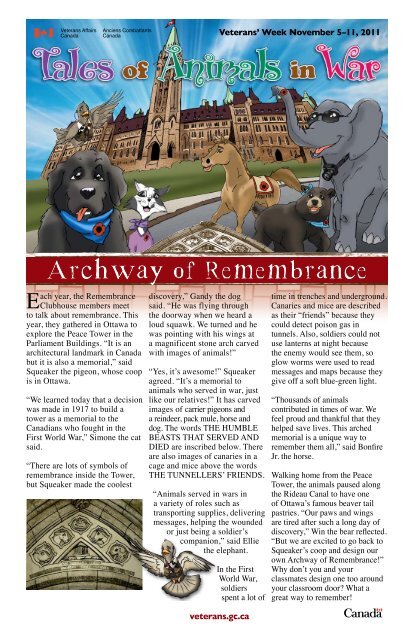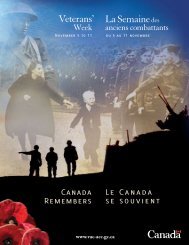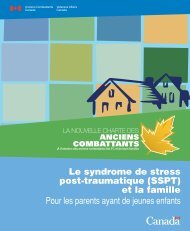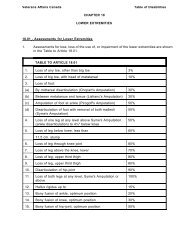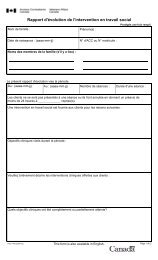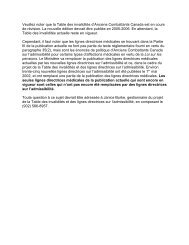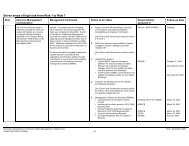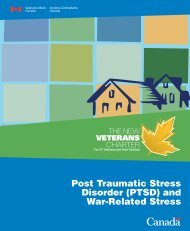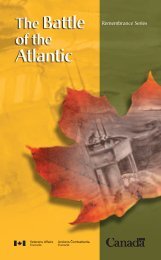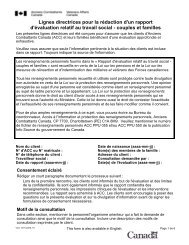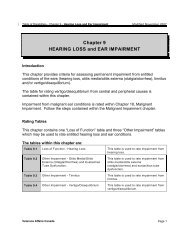Tales of Animals in War
Tales of Animals in War
Tales of Animals in War
- No tags were found...
Create successful ePaper yourself
Turn your PDF publications into a flip-book with our unique Google optimized e-Paper software.
Remembrance Clubhouse Family TreeCanadians all have different family backgrounds. Here are our brave ancestors.Do you know yours?Dur<strong>in</strong>gthe First World<strong>War</strong>, my relative Bonfirewas the best friend <strong>of</strong> aCanadian doctor and poet namedJohn McCrae. Bonfire carried thedoctor to the battlefield. Sadly, Dr.McCrae died <strong>in</strong> 1918. Bonfireproudly took part <strong>in</strong> hismilitary funeralprocession.Beachcomber be<strong>in</strong>g presentedwith his Dick<strong>in</strong> Medal.My relativeBeachcomber was a carrierpigeon dur<strong>in</strong>g the Second World <strong>War</strong>.He delivered important messages forCanadian soldiers. The messageswere rolled up and put <strong>in</strong> aconta<strong>in</strong>er attached to hisleg. He received the Dick<strong>in</strong>Medal for his courage. Hewas no chicken!Brita<strong>in</strong>’s People’s Dispensary for Sick <strong>Animals</strong>.Courtesy <strong>of</strong> Guelph Museums, McCrae HouseJohn McCrae on Bonfire.Harry Colebourn andW<strong>in</strong>nie <strong>in</strong> 1914.Myrelative was a bearcub. She was adopted as a mascotby a soldier from W<strong>in</strong>nipeg dur<strong>in</strong>gthe First World <strong>War</strong>. He named herW<strong>in</strong>nie! But it was too dangerouson the battlefield for her, so she wentto the London Zoo. While there, she<strong>in</strong>spired an author to write astory . . . W<strong>in</strong>nie the Pooh!Prov<strong>in</strong>cial Archives <strong>of</strong> Manitoba, Colebourn,D. Harry Collection, No. N10467First World <strong>War</strong> elephant.Myrelative Bandoolaserved dur<strong>in</strong>g the SecondWorld <strong>War</strong> <strong>in</strong> Burma, Asia. He andother elephants moved logs to buildbridges. They also carried peopleacross rivers and towed army trucksstuck <strong>in</strong> the mud. I will alwaysremember Bandoola!Illustrated <strong>War</strong> News. February 9, 1916.Dur<strong>in</strong>gthe SecondWorld <strong>War</strong>, my relativeSergeant Gander was amascot <strong>in</strong> Hong Kong. One night,a grenade was thrown at some Canadiansoldiers. Gander knew it was dangerous. Hetook it and ran away. Sadly, the grenadeexploded and Gander died. Hereceived the Dick<strong>in</strong>Medal.Able Seaman Simon and crewfrom the HMS Amethyst.Brita<strong>in</strong>’s People’s Dispensary for Sick <strong>Animals</strong>My relativeSimon served ona British warship <strong>in</strong> 1949.The ship was attacked <strong>in</strong> Ch<strong>in</strong>aand stranded for three months. Manysailors were hurt. Simon was hurt too butkept catch<strong>in</strong>g rats, which saved preciousfood. He also comforted the woundedmen. Simon was presented withthe Dick<strong>in</strong> Medal for hisbravery. What a coolcat!Hong Kong Veterans Commemorative AssociationGander with the Royal Rifles <strong>of</strong> Canadadepart<strong>in</strong>g for Hong Kong <strong>in</strong> 1941.This publication is available upon request <strong>in</strong> other formats. Toll-free: 1-877-604-8469 © Her Majesty the Queen <strong>in</strong> Right <strong>of</strong> Canada, represented by the M<strong>in</strong>ister <strong>of</strong> Veterans Affairs, 2011. Catalogue No.: V32-179/2-2011 Pr<strong>in</strong>ted <strong>in</strong> Canada2 veterans.gc.ca
Loveable MascotsDND ARMY 23177 and DVA 519-16Private P.T. Leachman with the donkeymascot <strong>of</strong> the Saskatoon Light Infantry.My relative W<strong>in</strong>nie was a loveablemascot for a group <strong>of</strong> Canadiansoldiers dur<strong>in</strong>g the First World<strong>War</strong>. Mascots represent groupsDid you know that many animals,like my ancestor Bandoola, havetransported supplies dur<strong>in</strong>g wartime<strong>in</strong> areas where vehicles couldn’ttravel over rough terra<strong>in</strong>?In the First World <strong>War</strong>, horses <strong>of</strong>tentransported soldiers and cannons<strong>in</strong>to battle. Donkeys and mulescarried supplies <strong>in</strong> mounta<strong>in</strong>ousItaly and <strong>in</strong> the jungles <strong>of</strong> Asiadur<strong>in</strong>g the Second World <strong>War</strong>.or teams. In the military, animalmascots <strong>of</strong>ten serve as pets toprovide fun and friendship.Many animals have served asmascots onboard Canadian ships.Playful dogs like Rags and Jeanniesailed dur<strong>in</strong>g the Second World<strong>War</strong>. Cats and even Muncherthe rabbit also had their “seapaws!” They provided comfort tosailors. Other animals, like Mike,the Sa<strong>in</strong>t Bernard, preferred dryland. He was the mascot <strong>of</strong> theAlgonqu<strong>in</strong> Regiment dur<strong>in</strong>gthe Second World <strong>War</strong>.Sometimes, they even gave tiredsoldiers a ride! Re<strong>in</strong>deer and camelsdid the same <strong>in</strong> the snowy Arcticand the arid desert.Elephants, strong and smart like me,carried supplies and helped to buildroads and camps <strong>in</strong> the jungles <strong>of</strong>Burma dur<strong>in</strong>g the Second World<strong>War</strong>.Brave beasts always pull theirweight!Mascots come<strong>in</strong> various shapes and sizes. Adonkey served as the mascot<strong>of</strong> the Saskatoon LightInfantry <strong>in</strong> Sicily <strong>in</strong> 1943.Batisse the goat, represent<strong>in</strong>gthe Royal 22 e Régiment,patrols the Citadelle, <strong>in</strong>Québec City. Today, theCanadian Army’s mascot isJuno, a cuddly life-size teddybear.Mascots, real or stuffed,always rally the troops! Doesyour school have a mascot?Movers and ShakersPack horses transport<strong>in</strong>g ammunition for theCanadian Field Artillery, April 1917.LAC PA-001231Did YouKnow?‘Joe the Crow’ and friend <strong>in</strong> 1950.Crowsnest magaz<strong>in</strong>e photo courtesy <strong>of</strong> CFB Esquimalt Naval &Military MuseumMore than 26,000Canadians took part <strong>in</strong> theKorean <strong>War</strong> between 1950and 1953. These <strong>in</strong>cludedmany brave sailors whoserved on destroyers <strong>of</strong>fthe Korean coast. Several<strong>of</strong> these ships had animalmascots, <strong>in</strong>clud<strong>in</strong>g Alice thedog on the HMCS Cayuga.A Canadian sailor hadrescued the stray pup fromdrown<strong>in</strong>g and she quicklybecame a friend for the men.And sailors back then mighteven have come across “Joethe Crow,” the mascot <strong>of</strong> thenaval tra<strong>in</strong><strong>in</strong>g base HMCSCornwallis <strong>in</strong> Nova Scotia.Colour Me!Diggers and SniffersM<strong>in</strong>e Detection Dogs Fanny and AlexCanadian Landm<strong>in</strong>e FoundationHave you ever heard theexpression, “an animal is a man’sbest friend? ” When war breaksout, it’s not just men and womenwho head <strong>of</strong>f to the battlefields.<strong>Animals</strong> <strong>of</strong>ten go with them.Over the years, animals havehelped Canada’s soldiers <strong>in</strong> manydifferent ways.Like my relative Gander, otheranimals have saved lives dur<strong>in</strong>gwartime. In the First World <strong>War</strong>,mice and canaries would helpthe soldiers who were digg<strong>in</strong>gtunnels by warn<strong>in</strong>g them whenthey smelled dangerous gases.German shepherds, like mycan<strong>in</strong>e friends Fanny and Alex,are very good sniffers. Theyworked with Canada’s army <strong>in</strong>Afghanistan to f<strong>in</strong>d roadsidebombs, explosive landm<strong>in</strong>es andmiss<strong>in</strong>g soldiers.An animal’s nose always knows!The Dick<strong>in</strong> Medal, which wascreated <strong>in</strong> 1943, is awardedto animals for their braveacts. Only 63 animals haveever received the honour: 32pigeons, 27 dogs, three horses,and one cat.The words on the medal say:“For Gallantry” and “We alsoServe.”The ribbon is striped:– green(for water and the naval forces)– dark brown(for earth and the land forces)– pale blue(for air and the air forces)veterans.gc.ca 3
Want to know why a pigeonlike me was up there at the verytop <strong>of</strong> the carv<strong>in</strong>g <strong>in</strong> the PeaceTower? In times before cellphones, text<strong>in</strong>g and Facebook,carrier pigeons deliveredimportant <strong>in</strong>formation becausethey were so good at f<strong>in</strong>d<strong>in</strong>gtheir way from one place toanother. Soldiers would attachnotes to the pigeons and thenDeliver<strong>in</strong>g the Newsrelease them to fly back to theircoops.My ancestor Beachcomber wasthe bird that delivered newsabout the raid <strong>in</strong> Dieppe, France,dur<strong>in</strong>g the Second World <strong>War</strong>.More than 900 Canadians werekilled <strong>in</strong> the difficult attackon the seaside town. A lot <strong>of</strong>carrier pigeons were also useddur<strong>in</strong>g the First World <strong>War</strong>. Ifthe enemy soldiers saw a pigeonfly<strong>in</strong>g by, they would shoot at itbecause they knew it could becarry<strong>in</strong>g an important message.But we pigeons are super speedy.We can fly up to 100 kilometresper hour and that’s why the newsusually got through! Some birdseven delivered their messagesafter be<strong>in</strong>g wounded.Royal Air Force carrier pigeon, 1942.Imperial <strong>War</strong> Museum.The <strong>Animals</strong> <strong>War</strong> Exhibition.Dogs and cats were messengerstoo, carry<strong>in</strong>g <strong>in</strong>formation <strong>in</strong>conta<strong>in</strong>ers around their necks<strong>in</strong> dangerous war zones. Weanimals always deliver!Breakthe CodeMessages carried by pigeons were usually written <strong>in</strong>code <strong>in</strong> case they fell <strong>in</strong>to enemy hands. Put on yourth<strong>in</strong>k<strong>in</strong>g hats and decipher the code to read thissecret message.__ __ __ __ __ __ __ __ __20 8 5 8 21 13 2 12 5__ __ __ __ __ __ __ __ __ __2 5 1 19 20 19 20 8 1 20__ __ __ __ __ __ __ __ __19 5 18 22 5 4 1 14 4__ __ __ __4 9 5 4H<strong>in</strong>t: These words can be found carved <strong>in</strong>side the Peace Tower.Code break<strong>in</strong>g key: A=1, B=2, C=3, etc.Cavalr y Charge!Whoa, partner! I am go<strong>in</strong>g totell you about someth<strong>in</strong>g coolthat animals like me did <strong>in</strong> warslong ago. Horses were used <strong>in</strong>cavalry units, where soldiersfought on horseback. <strong>War</strong> horseshave been used for thousands <strong>of</strong>years, like when knights used toride us <strong>in</strong> the Middle Ages!My ancestor Bonfire knew acouple <strong>of</strong> cavalry horses dur<strong>in</strong>gthe First World <strong>War</strong>. They toldhim that fight<strong>in</strong>g on horsebackon the Western Front was verydifficult because the enemy haddeep trenches, mach<strong>in</strong>e guns,tangles <strong>of</strong> barbed wire andpoison gas. Dr. McCrae used totell Bonfire what it was like <strong>in</strong>the South African <strong>War</strong> back <strong>in</strong>1900. Canadian cavalry forceshad been important <strong>in</strong> thewide-open spaces over there.Imag<strong>in</strong>e how courageous ahorse would have to be tocharge through the gunfire and2 nd Canadian Mounted Rifles onpatrol <strong>in</strong> South Africa <strong>in</strong> 1902.explosions <strong>of</strong> a battle, with asoldier on his back shoot<strong>in</strong>g orsw<strong>in</strong>g<strong>in</strong>g a sword!LAC PA-173029Furry FriendsConnect the Dots!Purr! Cats like me and myancestor Simon are good at<strong>of</strong>fer<strong>in</strong>g furry comfort and af riendly ear to help people feelbetter. Many other k<strong>in</strong>ds <strong>of</strong>animals have been special petsdur<strong>in</strong>g times <strong>of</strong> war, keep<strong>in</strong>gpeople company when theywere far away from home.Lots <strong>of</strong> dogs have been <strong>of</strong>ficialor un<strong>of</strong>ficial pets, and otheranimals like ferrets, squirrels,mice and birds have also beenspecial friends to lonely soldiersover the years. But I haveto say the Canadian Forcesmembers serv<strong>in</strong>g <strong>in</strong> Kandahar,Afghanistan, have a prettyunique pet, a monkey namedLucy!We Remembrance Clubhouseanimals are very proud <strong>of</strong> ourLucy the monkey.Canadian Press / Bill Gravelandbrave relatives. Many Canadianshave served <strong>in</strong> the military anda lot <strong>of</strong> people have their owncourageous family members. Youknow what? I th<strong>in</strong>k you shouldask your parents or grandparentsif they know <strong>of</strong> any relatives,friends or neighbours who haveserved <strong>in</strong> the cause <strong>of</strong> peace andfreedom. Then you can learnabout these real-life heroes foryourself!Lieutenant-Colonel John McCrae and Bonfire4 veterans.gc.ca


